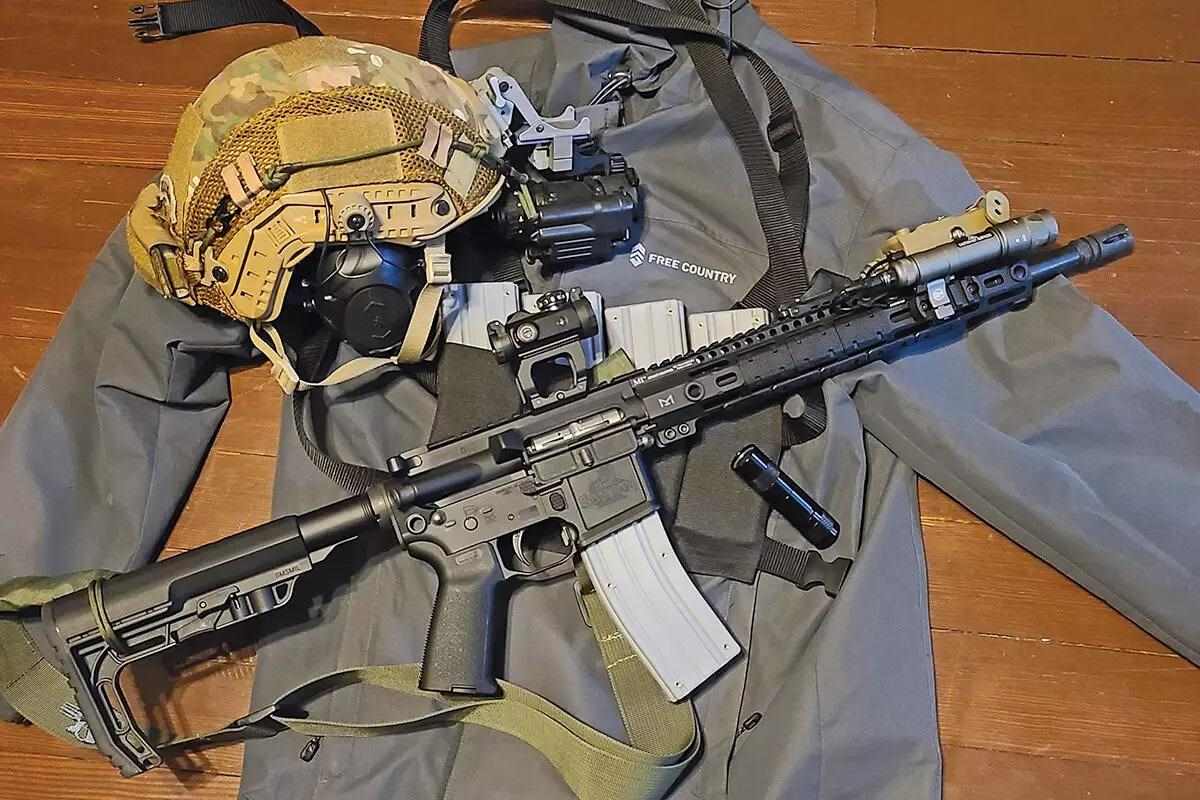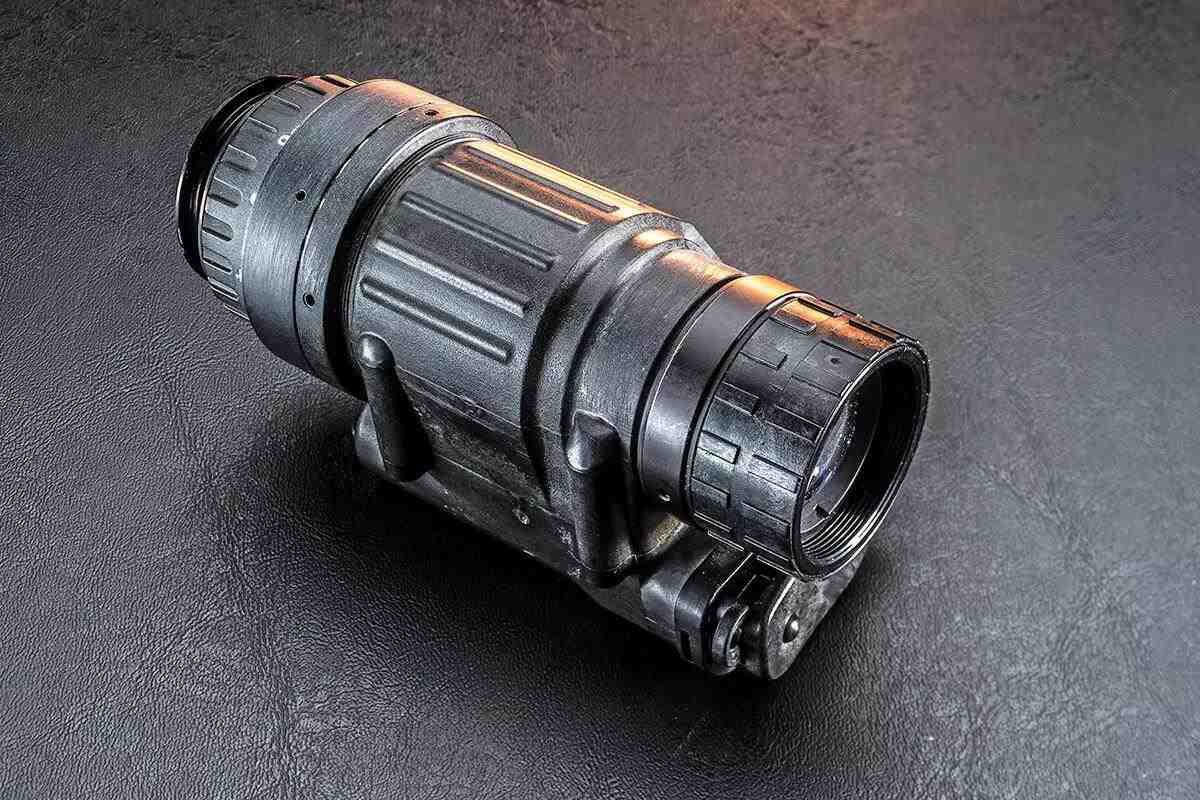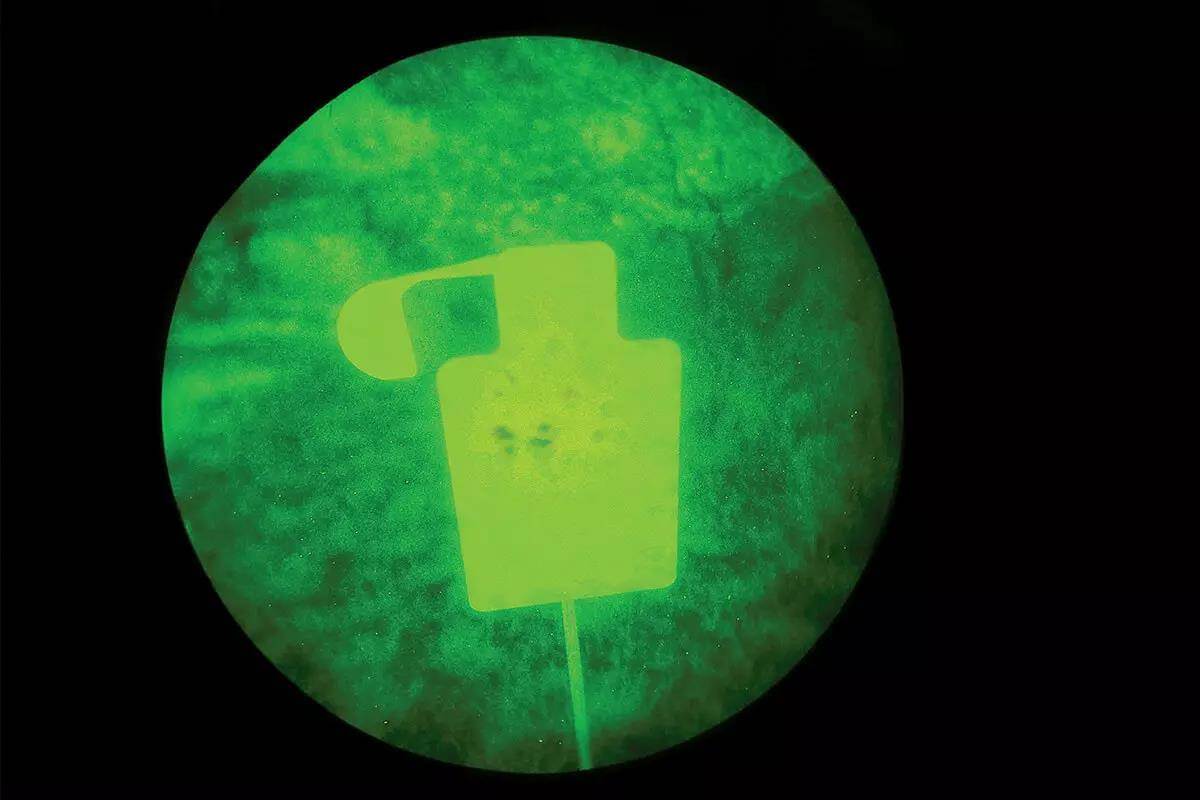Affiliate Disclosure: This page contains affiliate links. We earn from qualifying purchases.
As technology has advanced, many items formerly relegated to “Buck Rogers” are now not only available, but common. It wasn’t too many years ago that a GPS or handheld laser rangefinder would have been looked upon as something straight out of a science fiction movie. Today, they can be found in most gear bags. As technology steadfastly marches forward, modern electronics continually become smaller, more effective and less expensive. The same is also true of Night Vision Devices (NVDs). Like GPS and laser rangefinders, NVDs were originally designed with the military in mind. Today though, commercial NVDs are widely available. A highly useful tool in its own right, a quality NVD is something more and more outdoorsmen are interested in adding to their gear bag. Probably the most common “gateway” to owning night vision is by purchasing a PVS-14 monocular. This is a simple, robust and versatile night vision device widely fielded by the US military.
Before we jump into the PVS-14 though, let’s take a quick look at the origins of modern night vision. Like many ground breaking technological developments, the origins of night vision can be traced back to Germany. One of Hitler’s ‘super weapons,’ work on night vision devices was initially undertaken by “Heereswaffenamt” WaPruf 8 and the AEG in 1936. Work on this project was short-lived though, and did not begin again in earnest until 1943. Led by Ministerialrat Dr.-Ing. H. Gartner though, the Germans were able to not only rapidly develop but also field night vision equipment. Initially infrared night vision devices were developed for, and deployed, on Panther tanks and as driving equipment on supply trucks. Although the Germans may have begun work on night vision equipment in 1936, they did not make any real progress until 1943. During this same year American engineers tackled the problem of developing a working night vision device. Rather than developing it for armored vehicles though, the Americans wanted a weapon’s sight for use on the M1 carbine.
The result of their work was the Sniperscope T-120 developed in late 1943. This consisted of an Infrared spotlight and vertical grip mounted beneath the forearm and a scope capable of detecting IR light mounted atop the receiver. The scope, spotlight and vertical grip weighed in at 5.7 pounds. However, the complete weight of the system including the power supply and 6-volt battery tipped the scales at a portly 21.3 pounds. Range was only 70 to 100 yards. The T-120 was soon followed by improved M1 and M2 models. American units first fielded these early active night vision devices in April of 1945 on Okinawa. Although fewer than 500 units were deployed, they accounted for approximately 30% of all casualties suffered by the Japanese to small arms fire during the first week of this campaign. Despite this early success incompetence in the US Army prevented night vision equipment from being properly deployed until the war in Vietnam. The German Army requested a man portable Night Vision Device for use on small arms in October 1944. It was intended to protect armored units from night time attack by infantry tank-killer parties. At this time development of a small Infrared telescopic sight for use on the new 7.92x33mm Kurz Sturmgewehr 44 was requested. Despite pressure from both Allied bombing and the Soviet Red Army, within 5 months a working model, the Zielgerat 1229, was developed and fielded. Aptly code named the Vampir, it was similar in concept to the American T-120. Like the American design it allowed the gunner to detect and engage targets in total darkness by means of electronic detection of invisible infrared radiation.

The unit itself consisted of a small scope which attached to the weapon. Mounted to the top of this was an infrared spotlight. This projected infrared light invisible to the naked eye but discernible through the scope. Power came from a battery pack carried on the gunner’s back. While bulky, it allowed targets to be identified and engaged out to about 100 meters in total darkness. When first fielded it came as quite a surprise, and shock, to Allied troops caught in its invisible gaze. With the fielding of T-120 by US Marines and Vampir sights by Panzergrenadiers a new chapter of technology, and warfare, was begun. Since those first primitive T-120 and Vampir units went into action NVDs have made great strides forward. No longer simple active IR units dependent on an infrared light source; today’s NVDs are passive in nature amplifying available ambient light. So, let’s take a brief look at how this technology works.
Modern passive image enhancement night vision operates quite differently from the original active IR units. Rather than relying on an IR light source, modern passive units take the small amount of available light (such as from moonlight or starlight) and converts the light energy (protons) into electrical energy (electrons). These electrons then go through a thin plate containing millions of channels. As the electrons travel through they strike the walls of the channels releasing thousands of more electrons. These multiplied electrons then bounce off of a phosphor screen which converts the electrons back into photons. This provides an image to the ocular allowing you to see in the dark. Simple, right? Well, the important thing to understand is that all modern passive Night Vision Devices (or Starlight scopes) require some ambient light to amplify in order to see. If you were sealed in a dark room with no light, the best passive Night Vision available would be blind. So the performance of any NVD is directly related to the amount of ambient light available. As examples, viewing a snow covered field on a cloudless night with full moon and stars (optimum), or being in the woods on an overcast night with no moon or stars visible (poor conditions). Also, as Night Vision is very responsive to reflective ambient light, light reflecting off of fog or heavy rain may also seriously degrade performance. Performance is also directly related to the type of NVD in question. In this regard NVDs are classified by Generations. The higher the generation the more sophisticated the night vision technology. Generation 0: The earliest units dating from the 1940s and 1950s requiring an outside source of invisible infrared light to illuminate the viewing area. The last US military Gen O device was the AN/PAS-4 developed in 1962 for use on the M14 rifle and fielded until approximately 1970. Today this technology is reserved for equipment such as mounted security cameras.

Generation 1: This technology dates from the 1960s. Military units from this period are very large and heavy, common examples being the US Army’s AN/PVS-2 and Soviet 1PN-58. Currently there is a bewildering array of inexpensive commercial 1st Generation NVDs available. Performance of these cheap units is usually poor. Switching the unit on provides a dim, pale green image. The image itself is usually rather grainy with noticeable Geometric Distortion at the edges. Under ‘perfect’ conditions (cloudless sky with full moon and stars present) these units are certainly usable. As ambient light decreases, such as stepping into the woods or under cloud cover, performance drops off noticeably. In lowlight conditions these units benefit greatly from an IR illuminator, which basically acts as a flashlight. By teaming a high quality IR illuminator with a Gen 1 device, short range performance can be made acceptable. The end result of using a Gen 1 device teamed with an IR illuminator all the time though is very reminiscent of a Gen 0 device.
Generation 2: This technology dates from the 1970s and is a noticeable step up from the Gen 1 units. Military weapon sights from this period, such as the American AN/PVS-4 and Soviet 1PN-51, though smaller, are still rather large and heavy. The US AN/PVS-5 goggles though are a practical size. Commercial Gen 2 NVDs are noticeably more expensive than the Gen 1 units. However, they do offer a notable increase in performance. The image is usually flat with good resolution from its center almost to the edges. Gone is the Geometric Distortion of the Gen 1 units, and the image is noticeably brighter. Depending upon the model, tube quality and overall quality of manufacture a Gen 2 device can offer quite acceptable performance at a price many can live with. Performance though is still a step down from a high quality Gen 3 device.

Generation 3: Dating from the 1990s, a brighter sharper image was gained by adding gallium arsenide to the photocathode. An ion barrier film also increased tube life dramatically. Military units, such as the AN/PVS-14 are surprisingly small and lightweight. Performance is impressive. With a Gen 1 device, in poor lighting you strain so hard to discern something out of the snowy murk that you’ll just about pop a retina. With a Gen 3 unit night suddenly gives way to day. The image is very flat and clean from edge to edge. Resolution is very good and depth perception fairly good as well. The difference between a Mil Spec Gen 2 and Gen 3 unit is fairly substantial.
The workhorse night vision device currently fielded by US forces is the AN/PVS-14 (Army/Navy Portable Visual Search) monocular. Utilizing military grade Generation 3 technology, this compact device has proven extremely effective in combat. It is also hugely popular on the commercial market. The AN/PVS-14 is only 4.5 inches long and weighing in at just 13.8 ounces there’s a lot of performance stuffed into this small package. Examining one of these devices you first notice a soft rubber eyecup and an adjustable ocular. To the front of the ocular is the power control switch. This turns the unit On and Off and also controls the built in IR illuminator. At the front of the housing is a manual gain control knob for adjusting the image tube brightness. Brightness gain is adjustable from 25 to over 3,000 fl/fl. Next to this is the battery compartment. Power is supplied by two ‘AA’ batteries on older units and one ‘AA’ battery on newer units. Battery life is approximately 50 hours at room temperature. The objective lens is an F/1.2 approximately 24mm in diameter which is adjustable for focus. Magnification is 1x. Field of view is 40 degrees and focus range is from 25 cm to Infinity. Resolution is typically 64 lp. All in all it’s very simple and straightforward to operate.

Power the AN/PVS-14 up and night suddenly gives way to day, performance is, to say the least, impressive. The image is very flat and clean from edge to edge. Resolution is very good and depth perception fairly good as well considering it’s a monocular. One of the strong points of the AN/PVS-14 is its versatility. It can be handheld, helmet/head mounted or weapons mounted. It can also be attached to a tripod, camera, or camcorder. Accessories include helmet mounts, illuminated compass, higher magnification lenses and a variety of weapons mounts. Is it perfect? No. The gain adjustment knob’s placement appears to be an afterthought, and battery cap breakage/loss has been a problem on the early models. Plus, if the device is focused to see distant objects, you need to refocus to see objects up close to you. Also, depth perception of a monocular is not as good as a binocular. Despite these issues, the PVS-14 has proven very popular and highly effective. If you are looking at getting into night vision, this is the place to start.
Read the full article here


